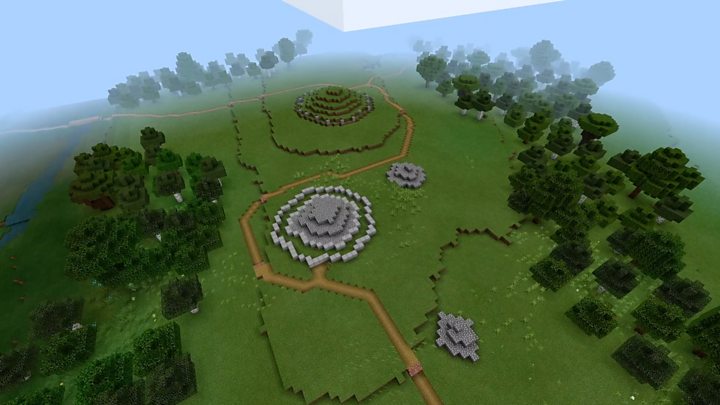Minecraft: Lockdown lesson recreates ancient island tomb

Media playback is unsupported on your device
Take an archaeologist, a bored schoolgirl living through coronavirus lockdown, and a shared interest in exploring ancient tombs.
The result? One of Wales’ most important Bronze Age sites recreated – in the video game Minecraft.
It is the achievement of Dr Ben Edwards, from Wrexham, and his daughter Bella, 11.
Their models of Bryn Celli Ddu on Anglesey are now being shared with classrooms around the world.
The models can be loaded into the block-building universe of Minecraft, and explored to learn more about both the site, Neolithic life and art.
The burial mound dates back an estimated 5,000 years, with its so-called “passage tomb” whose entrance aligns perfectly with the sun at dawn on the summer solstice.
The ancient and modern: Bryn Celli Ddu burial chamber for real – and in Minecraft
Image copyright
Rhys Thomas
The passage tomb aligns with the rising sun on the longest day of the year
More recent excavations at the site, including some by the Manchester Metropolitan University archaeologist Dr Edwards himself, revealed the burial chamber was built as a “henge”.
Like Stonehenge, this was a ritual enclosure consisting of a bank around an inner ditch, enclosed in a circle of upright stones.
Dr Edwards has used those digs, alongside work with researchers from the University of Central Lancashire and Wales’ historical environment service Cadw, to painstakingly recreate Bryn Celli Ddu in the video game.
It was then incorporated in the educational edition of Minecraft, which is used across the world to deliver lessons in anything from chemistry to computer coding.
You can now add ancient Welsh history to that list.
“I knew Bella had access to the education version of Minecraft at school here, near Wrexham, and I had access to it at my university.
“So it was always at the back of my mind for a while to do something in Minecraft,” said Dr Edwards, who has worked on other more grown-up computer models of Bryn Celli Ddu in the past.
“It was never a massive priority, but then you are in lockdown, it’s the Easter holidays, and you are home schooling.
“I just said to Bella: ‘Shall we have a crack at this?'”
Image copyright
Minecraft/Cadw/MMU
Real geographical data was used to map the virtual Minecraft site
The game is famous for players being able to build almost anything out of graphic blocks, creating massive worlds and playgrounds.
Though it may be a game, Dr Edwards took the approach to Bryn Celli Ddu seriously, and used actual geographical mapping data to recreate the landscape for the Minecraft models.
It includes the tomb itself, as it may have appeared in the Bronze Age, and alongside it other burial mounds and pits discovered in the last few years.
Rock art recovered from Bryn Celli Ddu is also represented in the game, alongside a model of what a Neolithic home may have looked like nearby.
According to Dr Edwards, the hardest thing to build was not the burial mounds or house.
“It was planting the trees,” he said.
Each one had to be individually “planted” and grown by Bella and her father as part of the Minecraft world.
“Bella had to show me how to do a lot of things, because she uses it more than me,” Dr Edwards confessed.
In the end, she approved of the final version and said it was “very realistic”.
“And she knows, because she used to come down to the excavations too,” her father added.
Image copyright
Minecraft/Cadw/MMU
A Neolithic settlement was recreated as part of the digital game project
Dr Ffion Reynolds, from Cadw, said it was exactly children such as Bella who would benefit from playing with the Minecraft model.
“We were looking for creative ways of providing people with a digital experience of Bryn Celli Ddu,” said Dr Reynolds, who would normally be spending the summer months giving guided tours of the excavations to schools from the area.
“This was a way of continuing our relationship with those schools, and offering them a way of ‘visiting’ the site digitally.”
Coronavirus restrictions mean Cadw’s sites across Wales have been closed to the public, including Bryn Celli Ddu.
It also meant, for the first time in years, those who celebrate the summer solstice were unable to gather at the burial mound to witness the dawn phenomenon there.
“However, it did allow us get access with a special camera crew, and we have been able to capture the sunrise there with 360-degree filming,” Dr Reynolds added.
She said Cadw hoped to make the footage available in the very near future, as well as reopening the site to visitors.
Meanwhile, those with access to Minecraft at home or in school can now visit the site digitally – in safety.
The Bryn Celli Ddu Minecraft world is free to download for the Minecraft Education version from Hwb – the Welsh Government’s teaching resource site, and also from the Manchester Centre for Public History and Heritage.
And for those looking for a more serious experience, Dr Andrews and his colleagues are behind an augmented reality app available for Apple devices, which can guide visitors around the real site – once it reopens.
